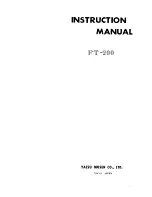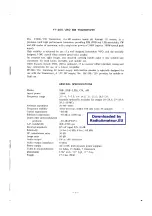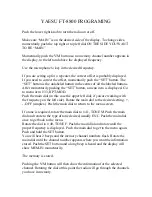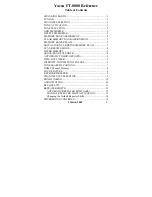
RC11xx(HP)-TM
RC25xx(HP)-TM
RC17xx(HP)-TM
2016 Radiocrafts AS
RC11xx(HP)/25xx(HP)/17xx(HP)-TM Data Sheet rev. 1.48 Page 21 of 86
2016 Tiny Mesh AS
Radiocrafts
Embedded Wireless Solutions
Sleep Mode
A Tinymesh™ Device may be set to sleep mode to reduce power consumption.
Note: When asleep, a Router Device will not provide network routing for other devices, and a Sleeping
Gateway device will not issue HIAM beacons.
Tinymesh™ networks will disconnect if no Gateway Device is active.
These conditions must be considered when designing a network with sleeping devices.
Sleep mode may be entered either by issuing the
SET SLEEP MODE
command while the module is in
CONFIGURATION MODE
, or by pulling the
RTS / SLEEP
pin low, after activating the SLEEP function
through proper configuration setting (
SLEEP OR RTS
).
The sleeping Device will wake up, go through a full Power-On Reset cycle and resume operation when:
•
The Configuration pin is driven high, if
SET SLEEP MODE
-command was used for entering sleep
mode.
•
When driving the
RTS / SLEEP
pin high, if the
RTS / SLEEP
pin was used to enter sleep mode.
To enter/ exit sleep mode using the
RTS / SLEEP
pin input:
1. Activate the
RTS / SLEEP
pin by setting
SLEEP OR RTS
configuration= 1.
2. Pull the RTS/SLEEP input low to enter sleep mode
3. Drive the RTS/SLEEP input high to exit sleep mode.
Note: The internal RTS/ SLEEP and CONFIG input pull-up resistors are disabled during sleep mode to
reduce excessive power leakage. The CONFIG and SLEEP inputs must therefore be actively driven to
the logic high state to exit sleep mode.
On exiting sleep mode, the Router Device will assume normal operation and connection to the mesh:
•
CTS will be high while the module is going through the Reset cycle, and then go low when the
module has made a valid network connection.
•
If
XON/XOFF
protocol is enabled, (
UART FLOW CONTROL)
, a single Xoff character will be
issued after completed reset cycle. The first Xon character will be issued after successful
connection to the mesh.
•
The
CONNECTION INDICATOR LED
will start flashing.
•
A
DEVICE RESET
message will be issued.
•
A
STATUS MESSAGE (IMA)
will be issued if
IMA ON CONNECT
is enabled.
RF Jamming Detection and Alarm
The RF Jamming Detection feature is a unique Tinymesh™ function, providing timed logging and
alarming of RF conditions that may inhibit radio communication. Radio Frequency interference that may
influence RF connectivity may be present in form of intended (jamming) disturbance, or unintended
noise from electrical equipment or RF transmitters.
The following Configurable parameters control the RF Jamming alarm feature:
•
The
RF JAMMING DETECT
parameter sets the number of minutes of RF jamming that
constitutes an alarm condition. The default value is 0 = off.
•
The
RF JAMMING ALARM PORT
parameter selects the GPIO number (0-7) for local alarm
output.
•
The GPIO parameter sets the selected GPIO function as active low or active high output.
RF Jamming Detection in Packet Mode Systems
When RF Jamming Detection has been enabled by setting the
RF JAMMING DETECT
parameter
,
the
Tinymesh™ module will create an
RF JAMMING DETECTED
message that will be transmitted through the
mesh as soon as RF communication is re-established. The
RF JAMMING DETECTED
message
MESSAGE
DATA MSB
will indicate the duration of the jamming situation in minutes, and the
MESSAGE DATA LSB
will
indicate the time since the jamming condition ended in hours.
















































